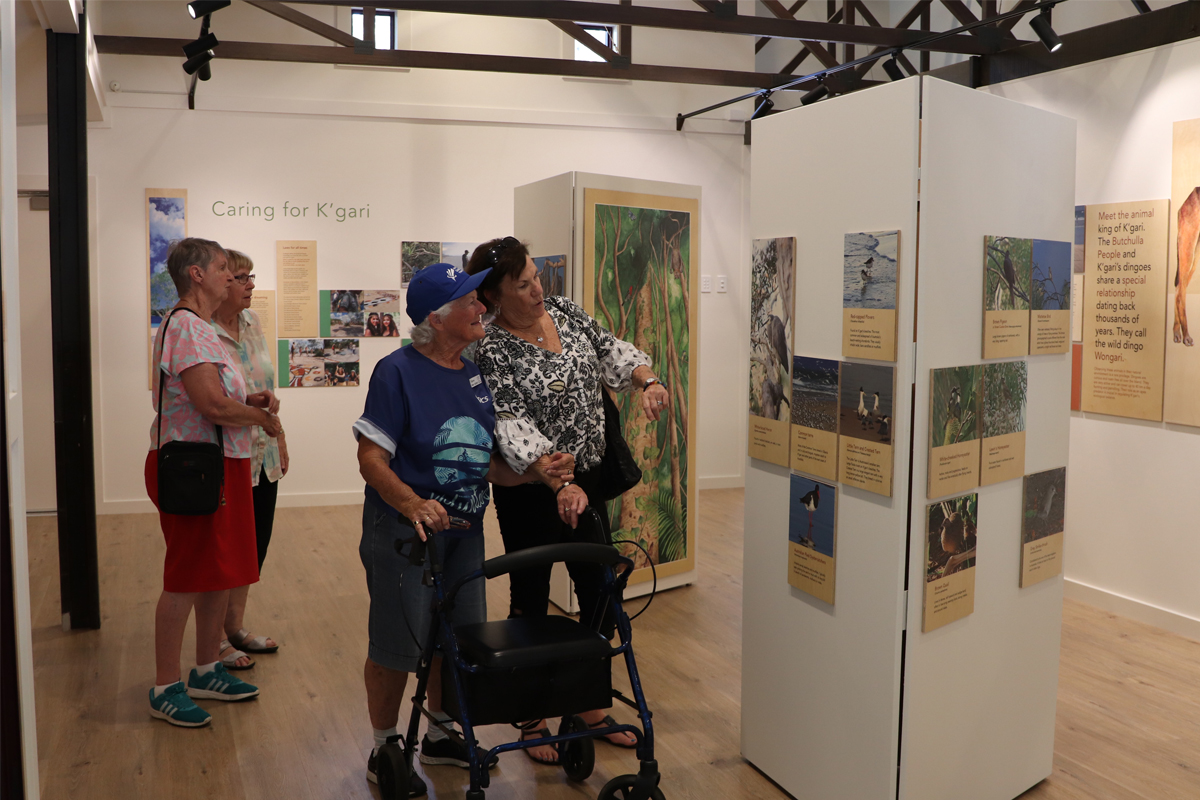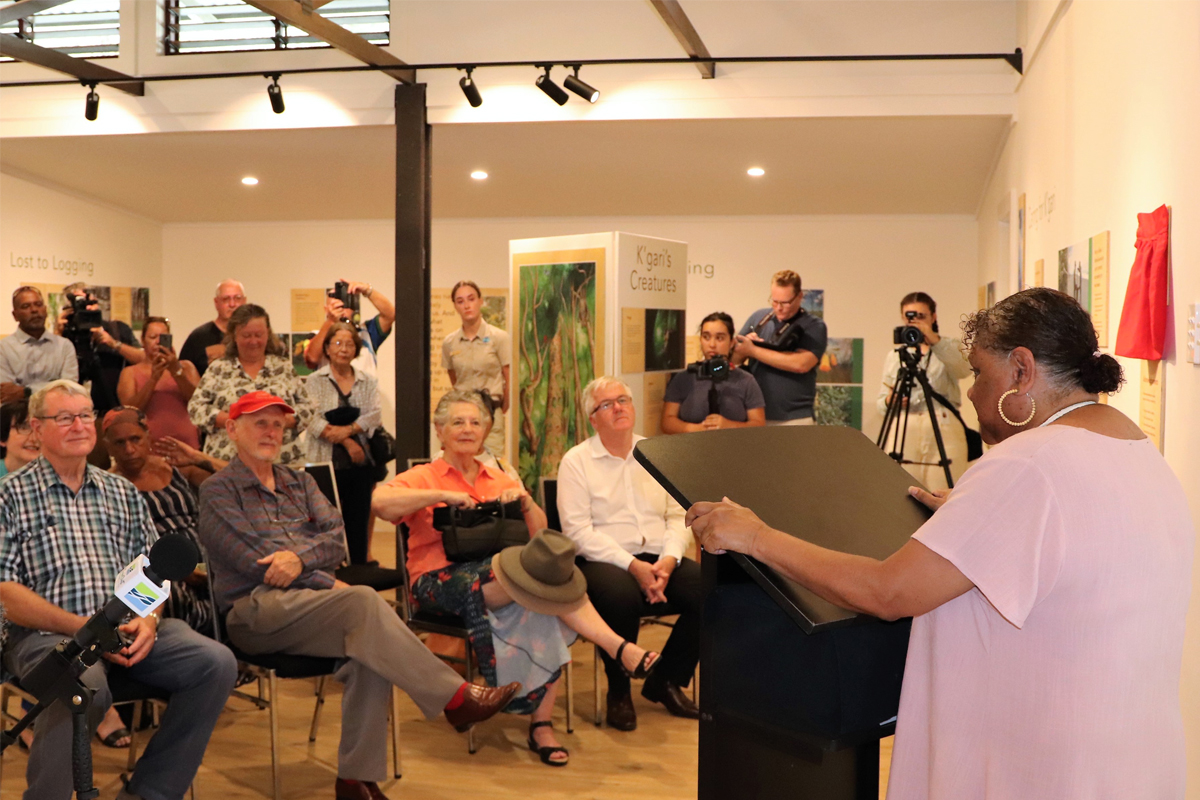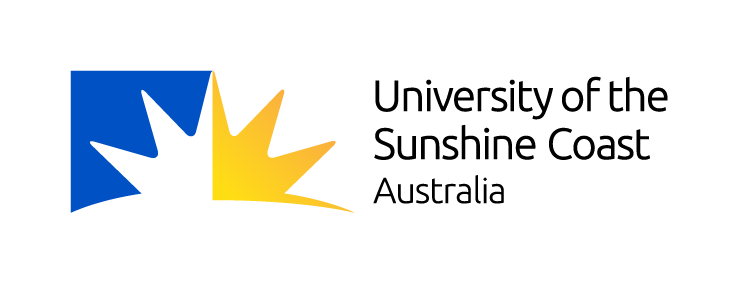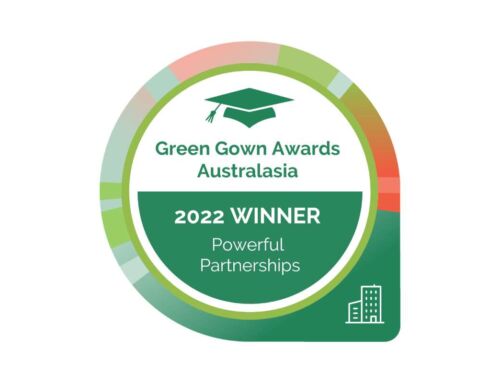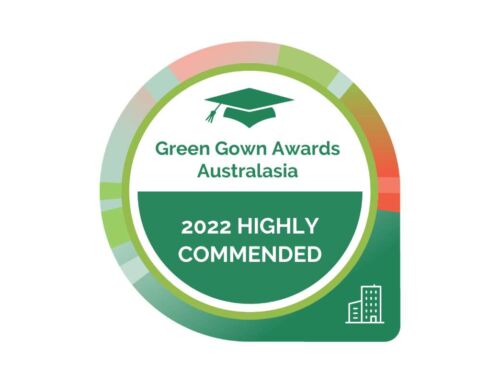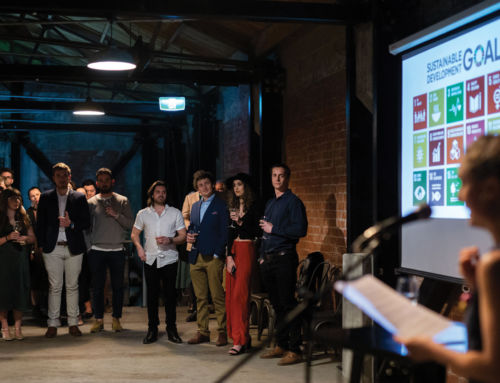K’gari World Heritage Discovery Centre
The K’gari World Heritage Discovery Centre is the first interpretative information Centre on World Heritage-listed K’gari (Fraser Island). It provides visitors with an understanding of the island’s World Heritage value and why the island should be protected. It was a partnership of the University of the Sunshine Coast (UniSC), Sealink’s Kingfisher Bay Resort (KBR) and the Butchulla Aboriginal Corporation (BAC). This innovative project aims to educate and inform visitors about the Island’s global ecological and cultural significance contributing to the conservation and protection of the island. Located adjacent to a key entry port to the island, the Centre tells the story of K’gari’s unique landscapes, ecology and cultural significance. The concept, interpretative panels and imagery were designed and developed by UniSC staff and Creative Industries students in collaboration with the BAC and other stakeholders. The Centre has become a highly visited site, attracting over 5,000 visitors in the past year.
> The initiative
The K’gari World Heritage Discovery Centre, located at Kingfisher Bay Resort on K’gari, provides visitors to the island with an understanding of the World Heritage value of the island and explains why the island should be protected. The aim was to develop a world class visitor experience that promotes K’gari’s UNESCO World Heritage status and highlights its unique environmental and cultural values. The centre, free to all, and with universal access, provides high quality interpretation aimed at encouraging visitors to play their part in the island’s protection and conservation. In creating the Centre, the focus was on the Island’s ‘outstanding universal value’ as identified by UNESCO; its culture and historical significance; partnerships, community and stakeholder input; potential to link to other interpretation facilities/centres on and off the island; and visitor management.
K’gari (Fraser Island), located within the Fraser Coast region, is the largest sand island in the world and is a place of exceptional beauty. Among its many striking features, the island is characterised by long beaches, tall rainforest, coastal heaths, freshwater lakes and ever-evolving sand dunes. The island has a long and continuous cultural presence. The Traditional Owners, the Butchulla people, hold Native Title over much of K’gari and co-manage the island with the Queensland Parks and Wildlife Service (QPWS). The recent devastating fires have highlighted the importance, and fragility of this unique landscape.
December 7, 2017 marked the 25th anniversary of “Fraser Island’s” listing on the World Heritage register. Despite the island’s significance as a unique World Heritage site there was no permanent display of information about its natural and cultural values prior to the development of the K’gari World Heritage Discovery Centre. Interpretation on the island and visitor management, in terms of protecting the island, are key issues for K’gari’s stakeholders including the K’gari World Heritage Advisory Committee (Department of Environment and Science – DES).
The Centre is part of UniSC and KBR’s commitment to increase understanding of K’gari’s exceptional Butchulla culture, which dates back more than 60,000 years, and address gaps in visitors’ knowledge of the island’s unique geology and ecology which led to its World Heritage listing.
Partnerships were crucial in the design, construction, compilation and eventual installation of the Centre. Located at a key entry point to the island on the main route to and from the Kingfisher barge, and in a busy area occupied by shops, spa and art gallery, the Centre is in an ideal location to attract visitors. KBR is the largest tourism business on K’gari and has led the way in eco-tourism in Australia for nearly thirty years. The property boasts a team of eco Rangers who provide interpretive activities for guests including walks, talks, food tasting, vehicle-based tours of the island & marine based tours of the Great Sandy Straits.
KBR worked with UniSC designers on the refurbishment of an existing building which was renovated to suit this purpose and which houses a range of interpretive displays which provide visitors with a greater understanding of what makes K’gari such a special and unique place. The BAC provided advice and content. Further assistance came from the K’gari World Heritage photo competition (DES) and other stakeholders. The interpretative panels, designed and compiled by UniSC staff and students, describe how wind, sand, water and plants have worked together since ancient times in an endless cycle to create K’gari’s complex systems of unique lakes, dunes, coloured cliffs and rainforests. Interpretation in the Centre starts with a Butchulla welcome and states the three Butchulla lores: (1) What is good for the land comes first; Do not touch or take anything that does not belong to you; and, If you have plenty you must share.
Key themes in the Centre are based on the World Heritage criteria: Theme 1 – Exceptional natural beauty (World Heritage List criterion VII). K’gari is the largest sand island in the world, containing a diverse range of features that are of exceptional natural beauty. Theme 2 – Significant ongoing geological processes (World Heritage List criterion VIII) including immense sand dunes, a variety of freshwater dune lakes which are exceptional in terms of number, diversity and age and the process of soil formation. Theme 3 – Significant ongoing biological processes (World Heritage List criterion IX) including rainforest vegetation with trees up to 50 metres tall on coastal dune systems, low shrubby heaths (‘wallum’) and fauna including a number of threatened species of frog. Theme 4 – Conservation of this amazing place. The island reveals Aboriginal occupation of tens of thousands of years.
Key threats requiring ongoing attention include climate change, biosecurity, degradation due to visitor numbers – recreational use of the area is intensive and localised and inappropriate fire management.
Visitors can learn about the island’s vegetation, birds and other wildlife, including rare and significant species that have adapted to its unique ecosystems, such as the dingo (Wongari) and acid frogs. The Centre is dynamic, providing space for a range of activities and presentations. KBR rangers meet groups in the Centre where they learn about K’gari’s culture and environment before embarking on activities. A space is provided for researchers and Citizen Science activities are planned in the future.
The Centre is an important first step towards expanding interpretation on K’gari and is designed to complement other planned interpretation on the island and wider region. The Centre now plays a central role in the development of comprehensive interpretive education for the island. In the future, it will link to, and direct, visitors to the planned K’gari Butchulla Cultural Centre at Central Station. Further interpretation is planned for Dilli Village. The emphasis in the Discovery Centre is on K’gari’s World Heritage value, the Cultural Centre will focus on the Butchulla story and Dilli Village interpretation will focus on the east coast environment and the sand mining story. The theme of Conservation: past present and future, will cut across all sites.
The Centre has become a highly visited site, attracting 5,000 visitors between June 2021 and June 2022.
> Environmental and social benefits
The key benefits are protection of a fragile environment and respect for Butchulla culture. An estimated 400,000 tourists visit K’gari annually which presents management and conservation challenges associated with tourism, biosecurity threats, vegetation management practices and climate change. A key question is whether the requirements for sustaining island ecological integrity can be met in the future.
Environmental harm resulting from visitation (e.g., damage to habitats and biota caused by off-road vehicles, campfires, bacterial contamination of freshwater lakes and groundwater from dune campers) is considered a major threat. Environmental impacts are further exacerbated by unnatural fire regimes, invasive and feral species and climate change. It is imperative to the sustainability of the island that visitors are educated about the need to protect the fragile environment.
The island offers a rare opportunity for people to observe and encounter wildlife, including dingoes. Although most dingo encounters are benign, occasionally negative and high-risk encounters of aggression towards humans cause injury. Managing the complex issues surrounding human interactions with dingoes on the island is challenging. Interpretation and education, and strict regulations against feeding are key to dingo management. The Discovery Centre dedicates a series of interpretative panels to the dingo, explaining why they are iconic and how human behaviour can change dingo behaviour.
Nearly 3000 school students stay at KBR annually while other school groups frequently visit during their stay on the island. All these students are encouraged to visit the Centre. The potential offered by the Centre in educating these students about the island and, more broadly about sustainability and cultural respect, is significant.
> Leadership and engagement
UniSC’s leadership and engagement within the region. The Fraser Coast is a regional community which includes Hervey Bay, Maryborough, Tiaro, Woocoo and Biggenden. In total the region has a population of 101,500. It is amongst the Queensland regional communities with the lowest uptake of tertiary studies, being around 8% in 2016. The K’gari World Heritage Discovery Centre aligns with UniSC’s Fraser Coast campus priorities including:
- Extend work place learning opportunities for students with local businesses, community groups and government agencies.
- Facilitate further opportunities for students to undertake study or research at Dilli Village on K’gari.
Interpretation: The K’gari World Heritage Discovery Centre along with the K’gari Mobile App. are leading interpretation on K’gari and making an important contribution to interpretation in the Fraser Coast region.
Research symposiums: UniSC has conducted two K’gari research symposiums, the first in 2018 and the second in 2021. Both were attended by approximately 100 participants from the local Fraser Coast and broader Queensland/ Australian communities. The research presented in these symposiums informed the content of the Discovery Centre.
> Significance to the sector
The proposal is distinctive in terms of:
- The partnership: the K’gari World Heritage Discovery Centre is the result of partners working closely together for a shared goal. The result is an initiative which is ongoing both in terms of the partnerships and impact on the community.
- Impact in relation to budget: the initiative has high impact in relation to the budget.
- The reach: Over 5,000 visitors have been to the Centre in the last year including a significant number of school students.
- Attract students to study at UniSC: potentially, the Centre attracts students to study at UniSC.
- Employment for UniSC graduates: UniSC graduates are employed as Rangers.
> Wider societal impact
The environment: The cost of environmental damage to K’gari is incalculable and the risk will grow with climate change. K’gari’s World Heritage status is also at risk. Visitor education is a significant step in the protection of K’gari’s natural and cultural value.
Tourism: The K’gari Discovery Centre potentially attracts visitors to the region. Tourism in the Fraser Coast Region, of which K’gari is a part, contributed A$430 million (Tourism Research Australia, Regional Tourism Satellite Accounts 2018-19).
> Learner/Graduate employer impact
UniSC students and internships are offered by KBR. Students learn at KBR and then often move on to other employers and tourist locations.
The hands-on learning and stakeholder engagement that UniSC graduates possess as a result of working on projects such as the Discovery Centre make them high-quality potential staff for employers.

